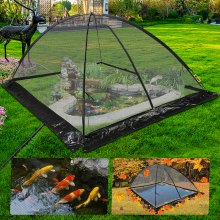
Covering your pond with pond nets is an excellent technique for keeping leaves and other waste out. They prevent undesired organic debris from collecting at the pond's bottom.
Before the leaves drop in the fall, you can lay the net across your pond, then remove it again in the spring or once the trees have lost their leaves.
The best way to maintain the cleanliness and safety of your pond is with VEVOR Covers. They're more than simply accessories; they're vital defenders of your tranquil underwater haven.
Although netting is a helpful pond tool, improper usage can harm fish and vegetation. Netting has a varied purpose for each season. This is how to maintain the best possible condition for your pond and pond net throughout the year.
Most pond owners will remove the netting in their ponds unless they have a serious predator problem. This gives you unhindered views and convenient access to the pond for upkeep and fish feeding.
Pond netting is often deployed in the spring to help shield new plants from animals and rabbits. It also discourages raccoons, herons, and other predators from using your pond as a feeding source.
A predator will rapidly conclude that they might never find a meal at your pond and that it's time to try their luck at another fishing hole if they return a few times without success.
Pond netting isn't supposed to be utilized in the cold. When every one of the leaves is gone but before the first significant winter storm, remove your pond nets.
If there is a buildup of ice and snow on the netting, it could fall into the pond. Heavy netting can trap fish, and the ice hole that allows for gas exchange may become compromised.
Fall is the best time of year to use pond cover nets. Pond owners are aware that their leaves will ultimately fall into the water when they begin to change color.
If there is a significant buildup of rubbish at the bottom over the winter, the fish's and the pond's health may suffer. Fish stress is caused by ammonia added to the water by debris left in the pond to degrade during the winter.
Pond netting is inexpensive, simple to install, and offers several advantages for managing your pond. Therefore, there is no explanation for why it shouldn't be installed.
We have compiled the most crucial details on the many kinds of netting available to assist you in selecting the ideal pond netting for your needs.
Supported pond netting is typically secured with pegs or stakes and composed of premium nylon, polyethylene, or plastics. It is woven together in various ways to form distinctive mesh designs and structures.
The holes in the netting are square or diamond-shaped, serving the dual purpose of keeping predators out of the water and effectively trapping fallen debris.
Shade cloth pond netting is expertly woven from premium polypropylene to shield at least 70% of the sun's rays from entering your pond.
Shade cloth netting, similar to supported pond netting, is effective in gathering leaves, discouraging predators, and protecting from UV rays when installed.
Choose floating pond netting if you're looking for pond netting that is very simple to set up and take down. As its name implies, this netting floats on the pond's surface and only needs a small amount of pond edge security.
Floating pond netting is made of UV-stabilized nylon or polyethylene, lightweight and durable fabrics that preserve a more natural appearance.
Pond covers are necessary for several reasons, including their protective and useful roles in pond upkeep and enjoyment. Here are some reasons to think about purchasing a high-quality pond cover.
Safety is the main justification for using a pond cover, particularly if you have kids or pets. Families might feel more at ease knowing that children won't fall into the water by accident if there is a strong cover.
Covers help prevent organic items like leaves and twigs from falling into the water. This keeps the pond tidy and prevents organic waste from building up, which could decompose and lower the water quality.
Fish and other aquatic life may be harmed by various predators that ponds may draw, including cats and birds. A cover is a physical barrier to keeping the wildlife in your pond safe.
Pond coverings can help reduce algae growth by obstructing sunlight. Algal blooms can produce unattractive green slime and lower oxygen levels in the water, endangering fish and other marine organisms.
Selecting VEVOR Pond Covers for your backyard haven entails choosing unmatched protection and spotless upkeep. The premium materials used to create VEVOR's coverings allow them to be weatherproof and durable all year round.
Water and light may pass through their special mesh construction, essential for preserving the natural ecology while keeping out detritus and scaring off predators.
VEVOR covers are the perfect combination of practicality and style; they are simple to install and can be customized to fit any size pond.
Pond nets can help keep algae from spreading out of control in your pond, but they won't stop it from growing. Algae can be managed using various techniques, such as pesticides, physical removal, and alterations to the pond's surroundings.
Most pond covers, particularly netting or mesh varieties, let some air and light through. Thus, the oxygen levels shouldn't be greatly impacted. Solid coverings are less frequent for standard garden ponds but may affect gas exchange if sealed.
Pond covers can be fastened by weights, pegs, or specialized clips attached to the pond's sides. Ensure the cover is tight and firmly fixed to ensure maximum effectiveness and stop animals from getting below.